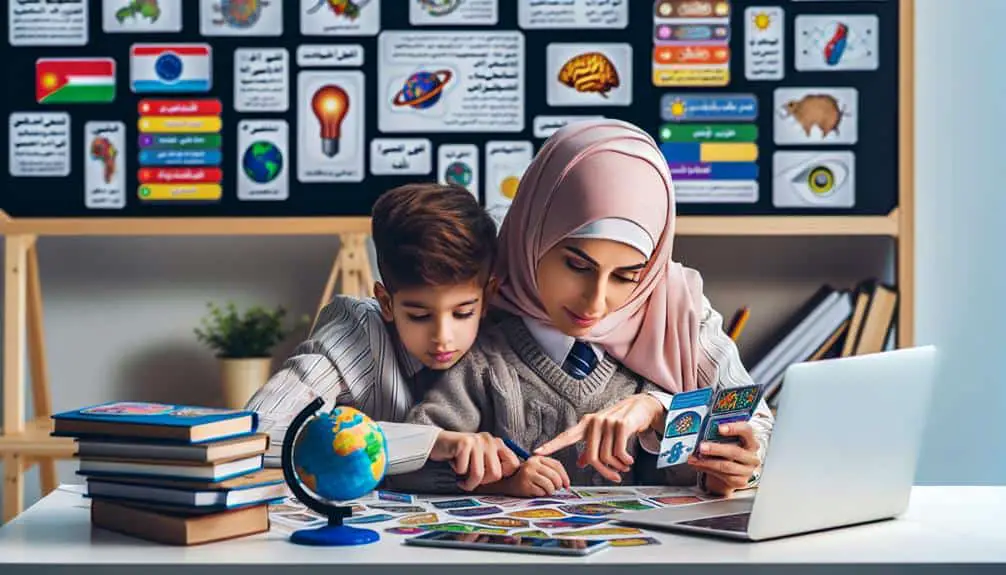Understanding your child's learning preferences in homeschooling is essential. Identifying their unique style helps tailor teaching methods effectively. By adapting to visual, auditory, kinesthetic, or reading/writing learners, you enhance their educational experience. Fostering a supportive environment, utilizing multi-sensory activities, and customizing the curriculum to individual preferences boosts comprehension and academic performance. Embracing these strategies results in a dynamic educational journey with greater engagement and ideal learning.
Key Points
- Identifying learning style enhances teaching effectiveness.
- Tailoring methods to preferences boosts engagement and comprehension.
- Supportive environment nurtures confidence and motivation.
- Multi-sensory activities improve memory retention and academic performance.
- Personalized curriculum fosters positive attitude and greater academic gains.
Identifying Your Childs Learning Style
To best understand how your child learns, it's essential to identify their unique learning style through observation and assessment. Understanding your child's strengths and weaknesses is vital in tailoring their homeschooling experience. By recognizing what engages your child and what challenges them, you can create personalized approaches that cater to their individual needs.
Observing your child during various activities can provide valuable insights into their learning style. Pay attention to how they interact with different subjects and tasks. Note what activities they excel in and which ones they find more challenging. Engaging activities that capture your child's interest can be a key indicator of their preferred learning style.
Once you have identified your child's learning strengths and weaknesses, you can adapt your teaching methods accordingly. By incorporating activities that align with their learning preferences, you can create a more effective and enjoyable learning experience for your child. Personalizing your approach based on their unique style can help enhance their understanding and retention of information.
Adapting Teaching Methods Accordingly
Adapting your teaching methods to align with your child's preferred learning style can greatly enhance their educational experience and foster improved understanding and retention of information. Customized approaches tailored to your child's specific learning preferences are fundamental in homeschooling. By identifying whether your child is a visual, auditory, kinesthetic, or reading/writing learner, you can adjust your teaching methods accordingly. For visual learners, incorporating diagrams, charts, and videos can be highly effective. Auditory learners may benefit from discussions, reading aloud, and using mnemonic devices. Kinesthetic learners thrive with hands-on activities and experiments, while reading/writing learners excel with written assignments and reading materials.
Ensuring student engagement is key when adapting teaching methods. Keeping your child interested and involved in the learning process promotes better comprehension and knowledge retention. Utilizing interactive tools, educational games, and real-life examples can enhance engagement and make learning more enjoyable. By incorporating customized approaches and prioritizing student engagement, you can create a dynamic learning environment that caters to your child's individual needs and maximizes their learning potential.
Fostering a Supportive Learning Environment
In homeschooling, creating a supportive learning environment plays a pivotal role in optimizing your child's educational journey and fostering academic growth. To create engagement and build confidence, consider establishing a designated study area that's free from distractions. This area should be equipped with necessary learning materials and resources tailored to your child's preferences and interests.
Encourage open communication, where your child feels comfortable asking questions and seeking help when needed. Providing positive reinforcement and constructive feedback can further enhance their confidence and motivation to learn.
Additionally, establishing a consistent routine can help create a sense of stability and predictability, which can be reassuring for children. Incorporating a mix of learning activities that cater to different learning styles can also keep your child engaged and motivated. By varying activities and incorporating hands-on experiences, you can make learning more interactive and enjoyable.
Incorporating Multi-Sensory Activities
Incorporating multi-sensory activities enhances children's learning experiences by engaging multiple senses simultaneously, fostering deeper understanding and retention of educational material. Hands-on engagement and interactive experiences play an essential role in homeschooling, allowing children to actively participate in their learning process. Research indicates that incorporating multi-sensory activities can improve memory retention, comprehension, and overall academic performance. By appealing to different senses such as touch, sight, and hearing, children are more likely to retain information and develop a deeper understanding of the subject matter.
Multi-sensory activities can include interactive experiments, educational games, and hands-on projects that cater to varying learning styles. These activities not only make learning more engaging but also help children make connections between theoretical concepts and real-world applications. By incorporating multi-sensory strategies into homeschooling curriculum, parents can create a dynamic and immersive learning environment that caters to their child's individual preferences and strengths.
Tailoring Curriculum to Individual Preferences
Tailoring the homeschooling curriculum to cater to individual preferences is essential for optimizing children's learning experiences and academic success. Personalized instruction allows for a tailored approach that considers each child's unique strengths, interests, and learning style. By customizing materials to align with these preferences, children are more engaged, motivated, and likely to retain information effectively.
Research shows that when children receive personalized instruction, they experience greater academic gains compared to traditional, one-size-fits-all approaches. Customizing materials can involve adapting the pace of learning, incorporating subjects that spark the child's curiosity, and utilizing resources that resonate with their interests. This tailored approach fosters a deeper understanding of concepts and promotes a positive attitude towards learning.
In homeschooling, the flexibility to tailor the curriculum provides a significant advantage. Parents or educators can adjust teaching strategies, assignments, and activities to suit the child's preferences, creating an environment where learning is enjoyable and meaningful. By embracing personalized instruction and customized materials, homeschooling can cater to the individual needs of each child, ultimately enhancing their educational journey.




